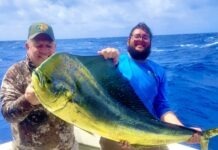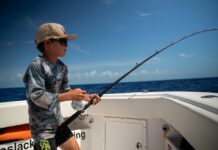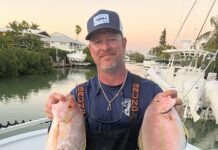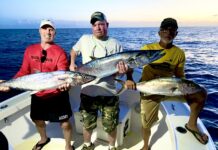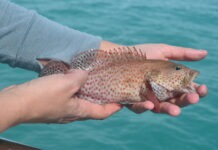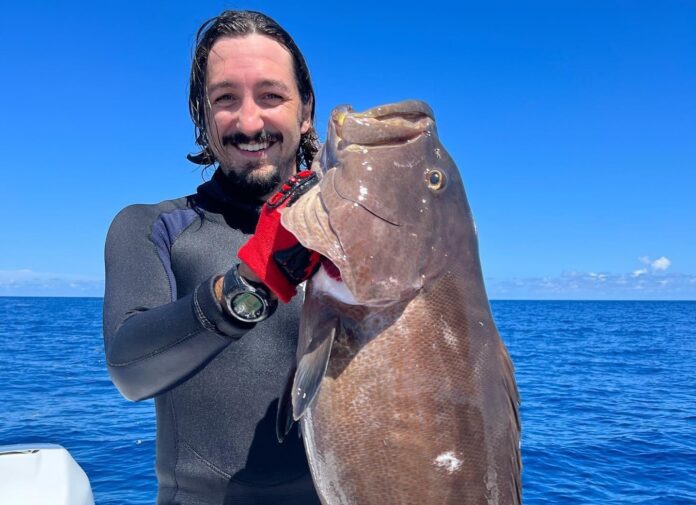
As the calendars turned to May this week, a fleet of boats with expectant anglers will descend with renewed fervor on the Keys’ reefs and wrecks. The opening of grouper and hogfish season every May 1 is nearly as much of a holiday for some local anglers as Christmas – but this year, a set of regulation changes will muddy the waters as anglers try to color within the lines of the law.
Though many are still unaware of the change, a NOAA Fisheries regulation enacted in October 2023 will significantly limit recreational, commercial and charter anglers targeting two species of grouper in federal waters – in other words, more than 3 nautical miles off the coast on the Atlantic side of the Keys, or 9 nautical miles into the Gulf of Mexico.
Grouper hunters have long been accustomed to harvesting a maximum of one black or gag grouper per angler per day, as part of the three-grouper daily aggregate – in other words, a recreational boat with four anglers could return to the dock with a maximum of 12 total groupers, including a maximum of four gag or black groupers, while the rest could be more loosely-regulated species like red grouper.
However, in an effort to rebuild struggling gag grouper stocks, the October 2023 rule imposes a vessel limit of two black or gag groupers per vessel per day – but only in federal waters. The translation: no more loading up the boat with friends and family, heading to the reef, and returning to the docks with a cooler full of black or gag groupers.
A shortened season is projected to close for gag grouper on June 15. Charter trips are similarly limited to two gag or black grouper per vessel per trip, while the rule also establishes a lower per-trip threshold of gag grouper harvest at 300 pounds gutted weight per trip
As published on NOAA Fisheries’ website, the rule change resulted from a gag grouper stock assessment that determined the species was over-fished, resulting in the 10-year rebuilding schedule now in place. The inclusion of black grouper in the new rule, the release stated, was due to misidentification issues between the two species, not a targeted rebuild of black grouper stocks.
“Gag and black grouper are often misidentified by recreational fishermen,” the release states. “Because of these misidentification issues, and with the need to greatly reduce the harvest of gag to rebuild the stock, the rule implements recreational harvest constraints for black grouper to indirectly benefit the gag portion of the snapper-grouper fishery.”
Though fishing the outer edges of the Keys’ reefs and wrecks, the majority of which fall in federal waters, will be more restricted, the rule does not apply to state waters, where the former grouper aggregate limit still applies without vessel limits.
The change leaves some anglers asking how to navigate the blurred line between the two fishing grounds when visiting both in a single trip – and raises questions of enforcement protocols for agencies like FWC. The obvious question: if a vessel reaches its limit in federal waters, can it move inshore to a location in state waters and harvest additional fish? And if so, how can anglers prove their catch is in line with the law?
“Be honest, tell us your story, and we’re going to ask some questions,” FWC Capt. David Dipre told the Weekly by phone. Though Dipre agreed that the new rule could allow boats with more than two anglers returning from federal waters to potentially harvest additional fish closer to shore, proof of the harvest locations could go a long way to answer officers’ questions.
“Leave your tracks (on your GPS) on, so that way you can show the officers where you’ve been and where you fished, and we’ll take it from there,” Dipre said. “We ask people to be patient, because if you are near the border of state and federal waters, officers will be asking you a number of questions about where you caught the fish.”
ADDITIONAL TIPS
- If planning a trip to fish in both state and federal waters, leave the “tracks” feature of your GPS on to verify your location and fishing spots throughout the day.
- Depending on users’ settings, the majority of smartphones have the ability to tag photos with GPS coordinates. Taking a photograph after catching each fish can help to verify its catch location.
- When in doubt, the Fish Rules app will provide fishing regulations and photos of various species for identification purposes based on your GPS location. Use it.
- Learn more about the new NOAA Fisheries rule here.















